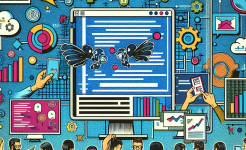Unclear Requirements and Scope
One of the primary challenges in agile development is dealing with unclear requirements and scope. In traditional development models, requirements are typically defined in great detail upfront. But in agile, the emphasis is on flexibility and adaptability, which can sometimes lead to a lack of clarity. Stakeholders may have different expectations, and requirements can evolve during the development process. This can result in scope creep, where the project expands beyond its original boundaries, causing delays and budget overruns.
To address this challenge, it is crucial to establish a strong communication channel between the development team, product owners, and stakeholders. Regular meetings, such as sprint planning and backlog grooming sessions, should be held to discuss and refine requirements. The product owner plays a vital role in prioritizing the backlog and ensuring that the team understands the business value of each item. Additionally, creating user stories can help to break down requirements into smaller, more manageable units. User stories are written from the perspective of the end-user and describe the functionality in a simple and understandable way. By focusing on user stories, the team can better understand the needs of the customers and deliver features that meet their expectations.
Another solution is to use techniques like prototyping and wireframing. These visual aids can help stakeholders to visualize the product and provide more accurate feedback. By getting early feedback, the development team can make adjustments to the requirements and scope before it's too late. Moreover, setting clear acceptance criteria for each user story can help to define the boundaries of the scope. The acceptance criteria should be specific, measurable, achievable, relevant, and time-bound (SMART), so that the team knows exactly what needs to be done to complete a user story successfully.
Team Collaboration and Communication
Agile development relies heavily on team collaboration and communication. In an agile environment, teams are often cross-functional, consisting of developers, testers, designers, and other specialists. However, bringing together individuals with different skills and backgrounds can sometimes lead to communication barriers and misunderstandings. Team members may have different working styles, priorities, and ways of communicating, which can impede the smooth flow of information and collaboration.

To overcome these challenges, it is essential to foster a culture of open communication and collaboration within the team. This can be achieved by promoting face-to-face interactions, such as daily stand-up meetings. During these meetings, team members can share their progress, discuss any issues or blockers, and coordinate their work. Additionally, using collaboration tools like project management software, instant messaging platforms, and video conferencing can facilitate communication, especially for remote teams. These tools allow team members to stay connected, share information in real-time, and collaborate on tasks regardless of their physical location.
Building trust and respect among team members is also crucial. Each team member should feel valued and respected for their skills and contributions. Encouraging a culture of feedback, both positive and constructive, can help to improve communication and collaboration. Team members should be comfortable providing and receiving feedback, as it can help to identify areas for improvement and enhance the overall performance of the team. Moreover, organizing team-building activities can help to strengthen the relationships among team members and improve their ability to work together effectively.
Managing Time and Resources
Agile development is based on the principle of delivering value in short iterations, known as sprints. However, managing time and resources effectively within these sprints can be a challenge. There may be pressure to complete tasks quickly, which can lead to rushed work and quality issues. Additionally, estimating the effort required for each task accurately can be difficult, especially when dealing with complex or unfamiliar requirements. This can result in unrealistic sprint plans and missed deadlines.
To address these challenges, the team should adopt a disciplined approach to planning and estimation. During sprint planning, the team should break down user stories into smaller tasks and estimate the effort required for each task. This can be done using techniques like story points or timeboxing. Story points are a relative measure of the effort required to complete a user story, while timeboxing involves setting a fixed time limit for each task. By using these techniques, the team can better estimate the workload and allocate resources accordingly.
It is also important to prioritize tasks based on their business value. The product owner should work with the team to determine the most important user stories to be included in each sprint. By focusing on high-priority tasks, the team can ensure that they are delivering value to the customers in a timely manner. Additionally, the team should regularly review and adjust their plans based on the actual progress. If a task is taking longer than expected or if new issues arise, the team should be flexible enough to make changes to the sprint plan to ensure that they can still meet their goals.
In conclusion, while the agile development model offers many benefits, it also presents several challenges. Unclear requirements and scope, team collaboration and communication issues, and managing time and resources are among the key challenges that agile teams often face. However, by implementing the solutions discussed in this article, such as establishing clear communication channels, fostering a culture of collaboration, and adopting a disciplined approach to planning and estimation, teams can overcome these challenges and successfully implement agile development. By doing so, they can deliver high-quality products more efficiently, respond quickly to changing requirements, and ultimately achieve greater success in the competitive software development market. Agile development is not just a methodology; it's a mindset that requires continuous learning, adaptation, and improvement. With the right strategies in place, teams can harness the power of agile to drive innovation and deliver value to their customers.
ARTICLE TITLE :3 key challenges and solutions of agile development model ,AUTHOR :ITpmlib

















